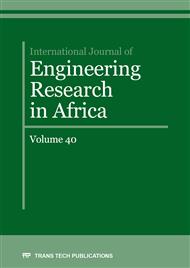[1]
J. Hossain, Wind Energy 2050-On the shape of near 100% RE grid, World Wind Energy Association, (2015).
Google Scholar
[2]
S. Kim, H. Shin, Y. Joo, K. Kim , A study of the wake effects on the wind characteristics and fatigue loads for the turbines in a wind farm, Renew.Energy.74 (2015) 536-543.
DOI: 10.1016/j.renene.2014.08.054
Google Scholar
[3]
D, Schillebeeckx, Study of wake effects in wind farms, (2014).
Google Scholar
[4]
H. Schümann, F. Pierella, L. Sætran, Experimental investigation of wind turbine wakes in the wind tunnel, Energy Procedia.35 (2013) 285-296.
DOI: 10.1016/j.egypro.2013.07.181
Google Scholar
[5]
J. S .González, A. G.Rodríguez, J. C. Mora, M. B. Payán, J. R.Santos, Overall design optimization of wind farms, Renew.Energy.36.7 (2011) 1973-1982.
DOI: 10.1016/j.renene.2010.10.034
Google Scholar
[6]
P. Mittal, K. Kulkarni, K. Mitra, A novel hybrid optimization methodology to optimize the total number and placement of wind turbines, Renew.Energy.86 (2016) ,133-147.
DOI: 10.1016/j.renene.2015.07.100
Google Scholar
[7]
W. Li, E. Özcan, R. John, Multi-objective evolutionary algorithms and hyper-heuristics for wind farm layout optimization, Renew. Energy .105 (2017) 473-482.
DOI: 10.1016/j.renene.2016.12.022
Google Scholar
[8]
P. Hou, W. Hu, C. Chen, M. Soltani, Z. Chen, Optimization of offshore wind farm layout in restricted zones, Energy .113 (2016) 487-496.
DOI: 10.1016/j.energy.2016.07.062
Google Scholar
[9]
D. Wilson, S. Rodrigues, C. Segura, I. Loshchilov, F. Hutter, G. L. Buenfil, S. Peña, Evolutionary computation for wind farm layout optimization, Renew. Energy, 126 (2018), 681-691.
DOI: 10.1016/j.renene.2018.03.052
Google Scholar
[10]
G. Mosetti, C. Poloni, D. Diviacco, Optimization of wind turbine positioning in large wind farms by means of a genetic algorithm, J. Wind Eng. Ind. Aerodyn.51.1 (1994) 105-116.
DOI: 10.1016/0167-6105(94)90080-9
Google Scholar
[11]
J. Herbert-Acero, O. Probst, P.-E. Réthoré, G. Larsen, K. Castillo-Villar, A review of methodological approaches for the design and optimization of wind farms, Energies .7.11 (2014) 6930-7016.
DOI: 10.3390/en7116930
Google Scholar
[12]
R. Shakoor, M. Yusri, A. Raheem,Y. Wu, Wake effect modeling: A review of wind farm layout optimization using Jensen׳ s model, Renew. Sustain. Energy Rev.58 (2016) 1048-1059.
DOI: 10.1016/j.rser.2015.12.229
Google Scholar
[13]
S. Chowdhury, J. Zhang, A. Messac, L. Castillo, Unrestricted wind farm layout optimization (UWFLO): Investigating key factors influencing the maximum power generation, Renew. Energy. 38.1 (2012) 16-30.
DOI: 10.1016/j.renene.2011.06.033
Google Scholar
[14]
W. Husien, W. El-Osta, E. Dekam, Effect of the wake behind wind rotor on optimum energy output of wind farms, Renew.Energy.49 (2013) 128-132.
DOI: 10.1016/j.renene.2012.01.048
Google Scholar
[15]
A. Behnood, H. Gharavi, B. Vahidi, G. H. Riahy, Optimal output power of not properly designed wind farms, considering wake effects, Int. J. Electr. Power Energy Syst.63 (2014) 44-50.
DOI: 10.1016/j.ijepes.2014.05.052
Google Scholar
[16]
J. Lee, E. Son, B. Hwang, S. Lee, Blade pitch angle control for aerodynamic performance optimization of a wind farm, Renew.Energy.54 (2013) 124-130.
DOI: 10.1016/j.renene.2012.08.048
Google Scholar
[17]
N. J. Choi, S. Hyun Nam, J. Hyun Jeong, K. Chun Kim, Numerical study on the horizontal axis turbines arrangement in a wind farm: Effect of separation distance on the turbine aerodynamic power output, J. Wind Eng. Ind. Aerodyn.117 (2013) 11-17.
DOI: 10.1016/j.jweia.2013.04.005
Google Scholar
[18]
A. Kusiak, Z. Song, Design of wind farm layout for maximum wind energy capture, Renew. energy.35.3 (2010) 685-694.
DOI: 10.1016/j.renene.2009.08.019
Google Scholar
[19]
S. A. MirHassani, A. Yarahmadi, Wind farm layout optimization under uncertainty, Renew. Energy. 107 (2017), 288-297.
DOI: 10.1016/j.renene.2017.01.063
Google Scholar
[20]
Y. Chen, H. Li, K. Jin, Q. Song, Wind farm layout optimization using genetic algorithm with different hub height wind turbines, Energy Convers. Manag..70 (2013) 56-65.
DOI: 10.1016/j.enconman.2013.02.007
Google Scholar
[21]
S. Xie, C .Archer, Self similarity and turbulence characteristics of wind turbine wakes via large ddy simulation, W.Energy .18.10 (2015) 1815-1838.
DOI: 10.1002/we.1792
Google Scholar
[22]
T. Göçmen, P. Van Der Laan, P. E. Réthoré, A. P. Diaz, G. C. Larsen, S. Ott, Wind turbine wake models developed at the technical university of Denmark: A review, Renew. Sustain. Energy Rev. 60 (2016) 752-769.
DOI: 10.1016/j.rser.2016.01.113
Google Scholar
[23]
S. Frandsen, R. Barthelmie, S. Pryor, O. Rathmann, and S. Larsen, Analytical modelling of wind speed deficit in large offshore wind farms, W. energy. 9 (2006) 39-53.
DOI: 10.1002/we.189
Google Scholar
[24]
N. O. Katic, I., Hojstrup, J., Jensen, A simple model for cluster efficiency. European wind energy association conference and exhibition. 1986. pp.407-410.
Google Scholar
[25]
T. Ishihara, A. Yamaguchi, and Y. Fujino, Development of a new wake model based on a wind tunnel experiment, Global wind power .6 (2004).
Google Scholar
[26]
J. Serrano González, M. Burgos Payán, J. M. R. Santos, F. González-Longatt, A review and recent developments in the optimal wind-turbine micro-siting problem, Renew. Sustain. Energy Rev. 30 (2014) 133-144.
DOI: 10.1016/j.rser.2013.09.027
Google Scholar
[27]
A. Peña ,O. Rathmann, Atmospheric stability-dependent infinite wind-farm models and the wake-decay coefficient, W. Energy .17.8 (2014) 1269-1285.
DOI: 10.1002/we.1632
Google Scholar
[28]
J. Feng, W. Z. Shen, Wind farm layout optimization in complex terrain: A preliminary study on a Gaussian hill, Journal of Physics: Conference Series.IOP Publishing. 524(2014).
DOI: 10.1088/1742-6596/524/1/012146
Google Scholar
[29]
M. Gaumond, P. E. Réthoré, A. Bechmann, S. Ott, G. C .Larsen, A Pena Diaz, K. S .Kurt, Benchmarking of wind turbine wake models in large offshore wind farms, Proceedings of the Science of Making Torque From Wind .2012, pp.9-11.
DOI: 10.1002/we.1625
Google Scholar
[30]
F. Port, Y. Wu, and C. Chen, A numerical study of the effects of wind direction on turbine wakes and power losses in a large wind farm, Energies. 6.10 (2013) 5297-5313.
DOI: 10.3390/en6105297
Google Scholar
[31]
Information on Https://www.thewindpower.net.
Google Scholar
[32]
Information on Https://en.wind-turbine-models.com.
Google Scholar
[33]
Vestas, General specification, V112-3.0 MW IEC IIA, 2 (2009).
Google Scholar
[34]
Thrust coefficient ENERCON E-82 E2 1 of 1 Rated power output : Power curve : Standard Air Density. 2010, p.82.
Google Scholar
[35]
S. J.Andersen, J. N. Sørensen, S.Ivanell, R. F. Mikkelsen , Comparison of engineering wake models with CFD simulations. In: Journal of physics: Conference series, IOP Publishing, 2014, p.012161.
DOI: 10.1088/1742-6596/524/1/012161
Google Scholar


